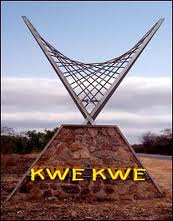Related Research Articles
Redcliff is a town situated in the Midlands Province of Zimbabwe, with a population of 41,526. It lies about 219 km (136 mi) north-east of Bulawayo.

Vale S.A., formerly Companhia Vale do Rio Doce is a Brazilian multinational corporation engaged in metals and mining and one of the largest logistics operators in Brazil. Vale is the largest producer of iron ore and nickel in the world. It also produces manganese, ferroalloys, copper, bauxite, potash, kaolin, and cobalt, currently operating nine hydroelectricity plants, and a large network of railroads, ships, and ports used to transport its products.

Kwekwe, known until 1983 as Que Que, is a city in the Midlands province of central Zimbabwe. The city has a population of 119,863 within the city limits, as of the 2022 census, making it the 7th-largest city in Zimbabwe and the second-most populous city in the Midlands, behind Gweru.

NMDC Limited,, is a government owned mineral producer. It is under the ownership of Ministry of Steel, Government of India.
Arrium was an Australian mining and materials company, employing nearly 10,000 workers, that went into voluntary administration in 2016 with debts of more than $2 billion. In 2017 it was acquired by British-owned Liberty House Group.
Iron ore production in Africa is dominated by South Africa, Mauritania and Algeria. Many countries possess iron ore deposits that are as yet untapped/unmined. Countries and companies currently involved in production are listed here; measurements are in tonnes per annum(year).

Mining in Iran is still under development, yet the country is one of the most important mineral producers in the world, ranked among 15 major mineral-rich countries, holding some 68 types of minerals, 37 billion tonnes of proven reserves and more than 57 billion tonnes of potential reserves worth $770 billion in 2014. Mineral production contributes only 0.6 per cent to the country's GDP. Add other mining-related industries and this figure increases to just four per cent (2005). Many factors have contributed to this, namely lack of suitable infrastructure, legal barriers, exploration difficulties, and government control.
Sydvaranger AS, previously A/S Sydvaranger, is an iron ore mining company operating in Sør-Varanger, Norway. Owned by Tacora resources, Sydvaranger owns an open-pit mine at Bjørnevatn and then hauls the ore with the Kirkenes–Bjørnevatn Line to Kirkenes for processing and shipping.
Amaveni Township is a high density suburb in Kwekwe, Zimbabwe. It is about 5 kilometres (3 mi) west of the city's central business district. The township's name of 'Amaveni' according to one of its first residents, the late Jonas Macela Nkomo (1908–2002), was derived from a Ndebele army's battalion that was called by the same name. The battalion fought during the 1893 Anglo-Ndebele war in Matebeleland region of Zimbabwe.

Kwekwe District is a district in Zimbabwe.

The Ravenscraig steelworks, operated by Colvilles and from 1967 by British Steel Corporation, consisted of an integrated iron and steel works and a hot strip steel mill. They were located in Motherwell, North Lanarkshire, Scotland.
The Crocodile Armoured Personnel Carrier or "Croc" is a Rhodesian armoured personnel carrier first introduced in 1977 and based on Japanese commercial trucks' chassis. It remains in use with the Zimbabwe National Army.

The steel industry in China has been driven by rapid modernisation of its economy, construction, infrastructure and manufacturing industries.

Sebakwe River or Zibagwe River is a river in Zimbabwe.
Bwana Mkubwa is a settlement and a mine in Copperbelt Province, Zambia. It is the oldest mine in Zambia's Copperbelt region. As a settlement with no municipal status, it became a locale due to the abundant copper deposits found in the area. Today, it is part of Ndola.
Mining in North Korea is important to the country's economy. North Korea is naturally abundant in metals such as magnesite, zinc, tungsten, and iron; with magnesite resources of 6 billion tonnes, particularly in the North and South Hamgyong Province and Chagang Province. However, often these cannot be mined due to the acute shortage of electricity in the country, as well as the lack of proper tools to mine these materials and an antiquated industrial base. Coal, iron ore, limestone, and magnesite deposits are larger than other mineral commodities. Mining joint ventures with other countries include China, Canada, Egypt, and South Korea.
Sebakwe Dam is a dam in the Midlands Province of Zimbabwe. It was built in 1957 and owned by the Zimbabwe government. It is across Sebakwe River in the Sanyati Catchment Area.
Globe and Phoenix Mine is a gold mine in Zimbabwe. It is just outside Kwekwe CBD.
The Gaika Mine, now known as the Gaika Gold Fields, is situated in what was Chicago Farm just about 2 kilometres (1.2 mi) south of Kwekwe CBC. The Gaika Mine was the earliest mine developed in 1894, then Globe and Phoenix in 1895-1900, the Eldorado in 1905, the Antelope in 1908, the Cam and Motor Mine in 1909, the Shamva Mine in 1909-1910, and numerous others during the period 1895-1911.
Prag Lalloo Naran was a Zimbabwean politician and businessman recognized as a "Nationalist for the struggle for Zimbabwe’s independence," and a "leading member of the (Zimbabwe) Asian Community".
References
- 1 2 Leonard Tow The Manufacturing Economy of Southern Rhodesia: Problems and Prospects (1960) , p. 41, at Google Books
- 1 2 3 4 5 6 7 8 Tambo, Butler (25 March 2017). "Ziscosteel – What went wrong?". Sunday News. Retrieved 30 April 2018.
- 1 2 3 Mahove, Christopher (31 May 2016). "Welcome to Redcliff: the Zimbabwean steel town turned ghost town". Equal Times. Retrieved 30 April 2018.
- 1 2 Rich partner for Zisco [ permanent dead link ] (accessed 14 February 2008).